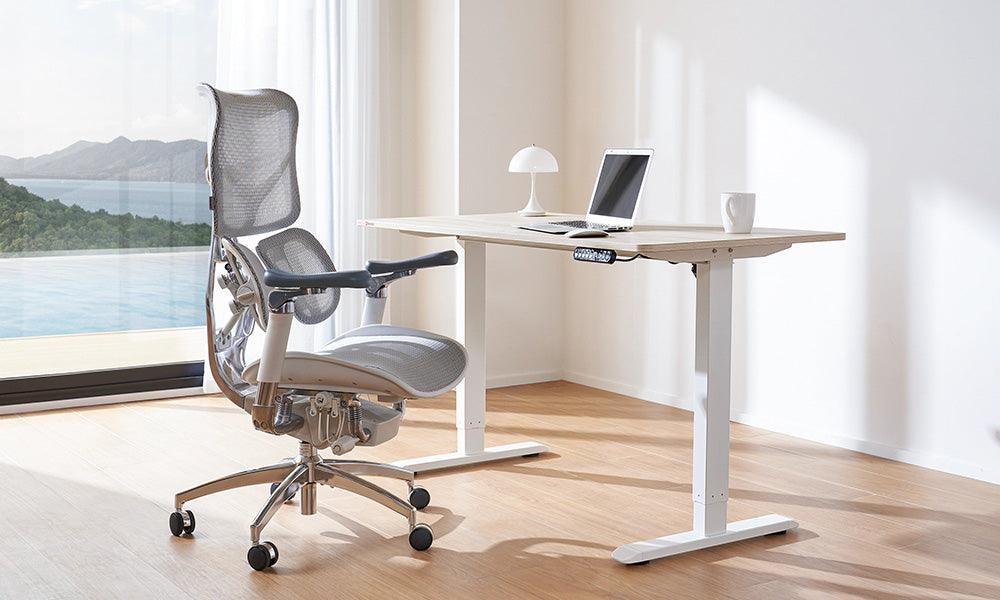For many office workers, the workday is a portrait in stillness. Hour after hour we're glued to our chairs, churning through emails, reports, and endless meetings. While the convenience of a comfortable chair is undeniable, this sedentary lifestyle comes at a cost. Research increasingly links prolonged sitting to a variety of health problems, including obesity, heart disease, and type 2 diabetes.
So, what's the solution? Is ditching the chair altogether the answer? Thankfully, the answer lies not in extremes, but in finding a balance between sitting and standing throughout the workday. This article will explore the benefits of both sitting and standing, provide tips on how to create a standing desk workstation, and offer strategies for incorporating movement throughout your day.
The Perils of Prolonged Sitting
Studies have shown that prolonged sitting can have a significant impact on our health. Here's a closer look at some of the potential consequences:
Increased risk of chronic diseases: Sitting for extended periods is linked to an increased risk of obesity, heart disease, type 2 diabetes, and even some cancers . This is because prolonged sitting leads to decreased activity of enzymes that break down fat and blood sugar in the body.
Musculoskeletal problems: Sitting all day can weaken core muscles and lead to back pain, neck pain, and other musculoskeletal issues.
Poor circulation: Sitting for long stretches restricts blood flow to the legs, which can increase the risk of blood clots and varicose veins.
The Benefits of Standing
Standing desks offer a multitude of benefits when incorporated into your workday:
Improved blood flow and circulation: Standing helps to keep your blood circulating, which can reduce your risk of blood clots and varicose veins.
Reduced risk of chronic diseases: Studies suggest that standing throughout the day may help to combat obesity, heart disease, and type 2 diabetes. By encouraging movement, standing desks can help to increase calorie burning and improve blood sugar control.
Increased productivity and focus: Some research indicates that standing can enhance alertness, energy levels, and focus, potentially leading to increased productivity. The change in posture may also help to combat fatigue and improve mood.
Improved posture: Standing encourages better posture, which can help to reduce back and neck pain.
Creating an Ergonomic Standing Desk Workstation
If you're interested in incorporating a standing desk into your work routine, here are some tips for creating an ergonomic workstation:
Desk height: The ideal desk height for standing should be slightly above elbow level when your arms are bent at a 90-degree angle.
Standing mat: An anti-fatigue mat can help to improve comfort and circulation while standing for extended periods.
Adjustable chair: Even with a standing desk, it's important to be able to sit down periodically. An ergonomic chair with good lumbar support is essential.
Monitor placement: Your monitor should be positioned at eye level to prevent neck strain. A monitor arm can help to achieve the desired height.
Keyboard and mouse placement: Your keyboard and mouse should be positioned so your wrists remain straight while typing.
Finding the Right Balance
While incorporating standing into your workday is beneficial, it's important not to go overboard. Aiming for a balance between sitting and standing is key. Here are some strategies:
Start slow: If you're not accustomed to standing for long periods, begin by standing for short intervals and gradually increase the duration throughout the day.
Listen to your body: Don't be afraid to sit down when you feel fatigue or discomfort.
Set a timer: Use a timer to remind yourself to switch between sitting and standing positions throughout the day. A good starting point might be 20 minutes standing, followed by 10 minutes sitting. Adjust this interval based on your own comfort level.
Incorporate movement: Take short walks or do some light stretches throughout the day to further improve circulation and prevent stiffness.
Deskercise: There are a variety of exercises you can do at your desk while standing, such as calf raises, squats, or arm circles to keep your blood flowing and muscles engaged.
Additional Considerations
Here are some additional factors to keep in mind when considering a standing desk:
Cost: Standing desks can range in price from relatively affordable to quite expensive. There are also DIY options available if you're handy.
Space limitations: Standing desks do require more space than traditional desks. Consider your available workspace before investing in a standing desk.
Company policy: Some companies have policies regarding the use of standing desks. Check with your employer before making any changes to your workstation.
Incorporating Movement Throughout the Day
In addition to incorporating standing into your workday, there are other things you can do to increase movement and reduce the negative effects of prolonged sitting.
Take regular breaks: Get up and move around at least every 30 minutes. This could involve taking a walk, doing some stretches, or simply standing up and refilling your water bottle.
Use the stairs: Whenever possible, take the stairs instead of the elevator.
Park further away: When parking at work or the grocery store, choose a spot that's a bit further away from the entrance.
Get active outside of work: Make sure to get regular exercise outside of work, such as going for walks, runs, or bike rides.
Conclusion
The key to a healthy workday is finding a balance between sitting and standing. By incorporating standing into your routine and increasing movement throughout the day, you can reduce your risk of chronic diseases, improve your posture, and boost your energy levels. With a little planning and effort, you can create a workstation that supports your health and well-being.



































